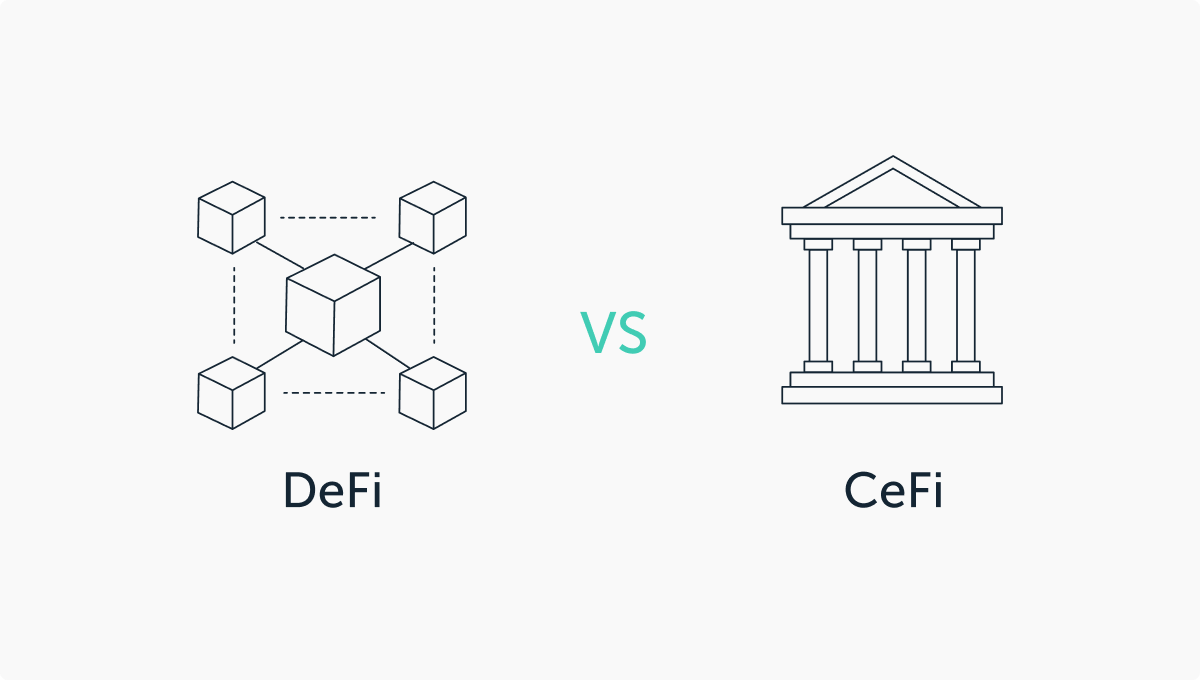Decentralized finance (DeFi) is a rapidly growing sector of the blockchain industry that has been gaining popularity over the past few years. DeFi is an umbrella term for financial applications and services built on top of blockchain technology, which enables users to access financial services in a decentralized and permissionless way, without needing to rely on traditional financial intermediaries. However, DeFi is not the only type of finance available in the market, and it is important to understand how it differs from traditional finance (TradFi) and centralized finance (CeFi). In this blog post, we will explore the key differences between these three types of finance.
DeFi
DeFi is a new type of financial system that is built on top of decentralized blockchain networks such as Ethereum. DeFi applications enable users to access financial services such as borrowing and lending, trading, insurance, and more, without the need for traditional financial intermediaries. Instead, these services are facilitated by smart contracts, which are self-executing code that automatically executes when certain conditions are met.
One of the main benefits of DeFi is that it is open and accessible to anyone with an internet connection, without the need for KYC or other traditional financial requirements. Additionally, DeFi is often cheaper than traditional finance, as it cuts out intermediaries and enables users to participate in the financial system without paying high fees.
However, DeFi is still a nascent industry and is subject to risks such as smart contract vulnerabilities and market volatility. Additionally, DeFi is not yet as user-friendly as traditional finance, and requires some level of technical expertise to navigate.
CeFi
Centralized finance (CeFi) is a type of finance that is controlled by a central authority, such as a bank or financial institution. CeFi operates on a centralized infrastructure and relies on intermediaries to facilitate financial transactions. Examples of CeFi include traditional banks, online payment platforms such as PayPal, and centralized cryptocurrency exchanges.
One of the main benefits of CeFi is that it is more user-friendly than DeFi, as it does not require as much technical knowledge to navigate. Additionally, CeFi is often more reliable than DeFi, as it is backed by established financial institutions with years of experience in the financial industry.
However, CeFi is subject to the risks of centralization, such as censorship, corruption, and security breaches. Additionally, CeFi often comes with higher fees and less transparency than DeFi.
TradFi
Traditional finance (TradFi) is a well-established industry that has been around for centuries. TradFi is the system of financial institutions, such as banks, insurance companies, and investment firms, that operate on a centralized infrastructure and rely on intermediaries to facilitate financial transactions.
TradFi is often associated with stability, security, and regulation, as it is heavily regulated by governments and has well-established institutions with years of experience in the financial industry.
However, TradFi is often associated with high fees, limited accessibility, and exclusivity, as it often requires significant amounts of capital to participate. Additionally, TradFi is subject to the risks of centralization, such as censorship, corruption, and security breaches.
Key Differences
DeFi, CeFi, and TradFi differ in several key ways, including their infrastructure, accessibility, and transparency.
Infrastructure
DeFi is built on decentralized blockchain networks, whereas CeFi and TradFi are built on centralized infrastructure. DeFi relies on smart contracts to automate financial transactions, whereas CeFi and TradFi rely on intermediaries to facilitate financial transactions.
Accessibility
DeFi is open and accessible to anyone with an internet connection, whereas CeFi and TradFi often require significant amounts of capital to participate. Additionally, DeFi does not require KYC or other traditional financial requirements, whereas CeFi and TradFi often require users to go through a rigorous onboarding process that includes identity verification and other regulatory requirements.
Transparency
DeFi is often more transparent than CeFi and TradFi, as it operates on a public blockchain network that enables anyone to view transaction data. Additionally, DeFi often publishes its smart contract code on public repositories, which enables users to verify that the code is secure and does what it claims to do. CeFi and TradFi, on the other hand, often operate on closed, proprietary systems that limit transparency and visibility.
Conclusion
DeFi, CeFi, and TradFi are all different types of finance that offer unique benefits and drawbacks. DeFi is a new type of finance that is built on top of decentralized blockchain networks, which enables anyone with an internet connection to access financial services without the need for traditional financial intermediaries. CeFi is a type of finance that is controlled by a central authority, such as a bank or financial institution, and operates on a centralized infrastructure. TradFi is a well-established industry that operates on a centralized infrastructure and relies on intermediaries to facilitate financial transactions.
Each of these types of finance offers unique benefits and drawbacks, and the right type of finance for you will depend on your individual needs and preferences. If you value accessibility, transparency, and low fees, DeFi may be the right choice for you. If you value stability, reliability, and ease of use, CeFi may be the right choice for you. If you value regulation, security, and exclusivity, TradFi may be the right choice for you.
Regardless of which type of finance you choose, it is important to do your research and understand the risks and benefits of each option before making any investment decisions. With the rise of DeFi and the increasing popularity of blockchain technology, we can expect to see continued innovation and growth in the financial industry, with more options and opportunities for investors and consumers alike.


